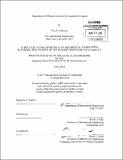Translation of dilution tolerance for gasoline SI engine
Author(s)
Niekamp, Troy S. (Troy Steven)
DownloadFull printable version (12.44Mb)
Alternative title
Translation of dilution tolerance for gasoline spark ignition engine
Other Contributors
Massachusetts Institute of Technology. Department of Mechanical Engineering.
Advisor
Wai K. Cheng.
Terms of use
Metadata
Show full item recordAbstract
There are a variety of fuel improvement strategies being developed for spark ignition engines which use dilution. Many of these technologies use a combination of different diluents. It is impractical in optimizing these technologies to test every possible combination of diluents. The purpose of this study was to determine a relationship between the various diluents and combustion related output parameters. One of these key outputs was determining the dilution tolerance for an engine. In order to achieve this goal, the fundamental of combustion were studied. The results from this study will be useful in developing more aggressive engine control strategies. Dilution has been studied extensively in previous research. Its effects are well known. Primarily, it reduces peak combustion temperatures. This can be used as an effective means to reduce losses and hazardous emissions. Too much dilution, however, and the combustion stability is compromised. To facilitate this project, an engine was fully instrumented. Experiments were performed for a variety of operating conditions and diluents. Results were then used to correlate the diluent properties and quantities to combustion outputs. Adiabatic flame temperature was first attempted as the key metric for correlation. This metric proved to be unsuitable for developing correlations. Later, a new metric was computed by taking a linear combination of diluents. This was found to offer superior results. Using this metric along with other basic engine measurements, correlations were developed between the diluents and engine output parameters. These output parameters include dilution tolerance, exhaust temperature, NOx emissions, and combustion bum durations.
Description
Thesis (S.M.)--Massachusetts Institute of Technology, Dept. of Mechanical Engineering, 2013. Cataloged from PDF version of thesis. Includes bibliographical references (p. 69-70).
Date issued
2013Department
Massachusetts Institute of Technology. Department of Mechanical EngineeringPublisher
Massachusetts Institute of Technology
Keywords
Mechanical Engineering.